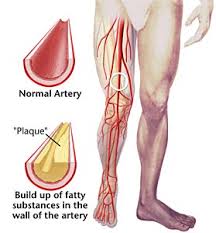Peripheral Vascular Disease refers to any sort of narrowing or occlusion of the arteries in the body, except heart. It is most commonly due to atherosclerosis and involves the arteries providing blood supply to the legs. Atherosclerosis causes plaque build up within the artery, restricting flow past the narrowing. PVD is widely used to refer to hardening of the arteries in the legs.
 Many people with PAD have no symptoms. However, some develop a painful ache in their legs when they walk, which usually disappears after a few minutes rest.
Many people with PAD have no symptoms. However, some develop a painful ache in their legs when they walk, which usually disappears after a few minutes rest.
Intermittent Claudication: Pain, cramp or fatigue in the muscles of the leg, which develops when walking. The calves are most often affected, but symptoms can extend from the buttocks, or thighs down to the calves. The symptoms usually improve with rest and recur with further walking.They are worse going up stairs or an incline.
Cold feet: As the only symptom this is more common in older patients who do not walk long distances.
Rest Pain: Pain in the foot or lower leg that is persistent (and present at rest, rather than being caused by walking). It is usually worse at night, and may be improved by hanging the leg down.
Ulcers: Sores on the leg or foot that are unduly slow to heal.
Gangrene: Blackened areas of skin on the toes or foot. These are often painful.
When atherosclerosis occurs in arteries of the heart, it is called coronary artery disease. Atherosclerosis in arteries of the brain is called cerebrovascular disease.
Atherosclerosis is by far the most common cause of PVD. It has a number of Correctable Causes. These are the focus of long term Preventative Treatment, which is usually supervised by the local doctor
Occasionally PVD is caused by something other than atherosclerosis -
Arteritis, Thrombotic Blood Disorders – also called Thrombophila, Radiation damage to arteries, Infection causing damage to arteries and Congenital narrowing of arteries.
PAD isn't immediately life-threatening, but the process of atherosclerosis that causes it can lead to serious and potentially fatal problems.
Coronary heart disease (CHD) The blockages in the arteries in the legs can also affect other areas of your body, such as the arteries supplying the heart and brain. This means that having PAD makes you more likely to develop another form of cardiovascular disease (CVD), such as: coronary heart disease, stroke, heart attack, or angina.
Critical limb ischaemia (CLI) TIf the blood flow to the legs becomes severely restricted, critical limb ischaemia (CLI) can develop. CLI is an extremely serious complication that can be challenging to treat.
Symptoms of CLI include: a severe burning pain in your legs and feet that continues even when you're resting your skin turning pale, shiny, smooth and dry wounds and ulcers (open sores) on your feet and legs that don't heal loss of muscle mass in your legs the skin on your toes or lower limbs becoming cold and numb, turning red and then black, and/or beginning to swell and produce foul-smelling pus, causing severe pain
Clinical Assessment with a detailed History and Examination is the cornerstone of diagnosis. This assessment guides the Investigations and Treatment Recommendations.
Duplex Ultrasound is the most common first line of Investigation. It provides images of the blood vessels and information about flow through the vessels. It is safe, and free of radiation.It is often done together with measurement of blood pressure at the ankles (ABI).
CT Angiography provides more detailed information about the anatomy of blood vessels (shape, size, course taken). It is a CT scan with injection of contrast into the vessels, allowing them to be clearly seen. It is used for planning and monitoring of treatment. It involves radiation.
Angiography provides the high quality information about the arteries that is often needed for treatment. It is done in Hospital under local anaesthetic. A catheter (fine tube) is introduced into the arteries and contrast is injected to provide images of the vessels and the disease within.
Blood tests may be done to check kidney function, blood sugar levels, cholesterol and other lipid levels and to exclude anaemia.
The goals of treatment are to reduce symptoms, improve quality of life, and preserve the limb. Treatment of PVD involves lifestyle changes, medications and surgery.
If arteries or veins are significantly blocked and blood flow to areas of the body (usually the legs) is restricted, we may perform a surgical procedure to open up the blockage and preserve function of the limb.
Minimally Invasive Surgery: Stents and Angioplasty
Minimally invasive surgery is the preferred treatment of peripheral vascular disease in this Practice. It is a constantly improving area of practice. Catheters and other equipment are introduced through pinhole entry of the arteries, usually in the groin. The aim is to increase blood flow through the treated artery, which has been narrowed or blocked by peripheral vascular disease.
The procedures are done under local anesthetic, sometimes with additional sedation, and patients go home on the day of treatment or the day after in most cases.